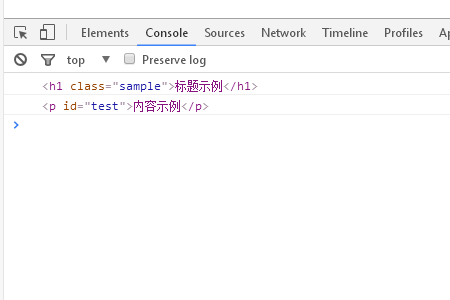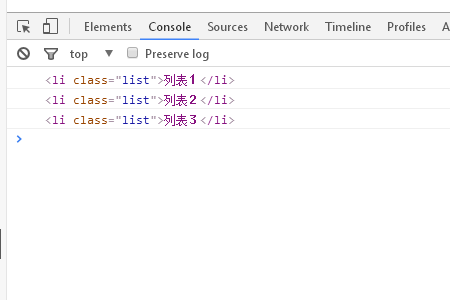 Web Front-end
Web Front-end
 JS Tutorial
JS Tutorial
 Introduction to the method of querySelector() in JavaScript to obtain HTML elements
Introduction to the method of querySelector() in JavaScript to obtain HTML elements
Introduction to the method of querySelector() in JavaScript to obtain HTML elements
QuerySelector() is a method that can detect and obtain any HTML element from JavaScript. Although JavaScript has had methods such as getElemenById() and getElemetnsByClasNamo() to obtain HTML elements from the beginning, if you use querySelector(), Then you can selectively specify HTML elements in the jQuery sense without knowing the id attribute value, class attribute value, etc.

#In short, you can use querySelector() to retrieve any HTML element.
Let’s first look at the basic syntax of querySelector()
querySelector() will usually be executed on the target range.
document.querySelector( CSS选择器 )
In this case querySelector() will be executed on the entire document. Arbitrary HTML elements can be obtained by specifying jQuery-like CSS selectors for parameters.
It should be noted that the program will end when it obtains the first matching HTML element.
In other words, if you want to get multiple elements, you need to create a loop process, or use what we will talk about later querySelectorAll().
Let's continue to seeHow to use querySelector()?
Get the HTML element with ID and Class attributes
The example is as follows
HTML
<h1 class="sample">标题示例</h1> <p id="test">内容示例</p>
JavaScript
var elem1 = document.querySelector('.sample'); var elem2 = document.querySelector('#test'); console.log(elem1); console.log(elem2);
The running results are as follows

You can see that each parameter of querySelector() specifies a CSS selector.
Thus, the same querySelector() can also obtain any HTML element according to the parameter specification method.
It can be seen from the execution result that the element has been obtained.
Let’s look at how to use querySelectorAll()
querySelectorAll() can get multiple HTML elements.
Let’s take a look at its basic syntax first
document.querySelectorAll(CSS选择器)
In this way, the method and target range of specified parameters are the same as querySelector().
The biggest difference is that you can get all matching HTML elements!
Since queryselector() can only retrieve the first matching element, we can use querySelectorAll() to get multiple elements.
Let’s look at a specific example
HTML code
<ul> <li class="list">列表1</li> <li class="list">列表2</li> <li class="list">列表3</li> </ul>
In this example, multiple list elements are arranged.
To retrieve all elements of this list, you can do the following
JavaScript
var elem = document.querySelectorAll('.list'); console.log(elem);
In this example, the class attribute value "list" is specified as the parameter of querySelectorAll() .
This will specify all list elements, so all list items can be obtained.
Of course, you can set the "li" element as is, but be careful about balancing it with other list elements.
The elements obtained by querySelectorAll() are called NodeList, which stores a data structure similar to an array.
Below we use 'forEach' to process one element at a time, which can effectively process the array repeatedly.
var elem = document.querySelectorAll('.list');
elem.forEach(function(value) {
console.log(value);
})The running results are as follows

In this example, the results obtained using querySelectorAll() are looped by the forEach statement.
By specifying the parameter "value", each HTML element can be obtained like the above results.
Note: You can perform arbitrary processing on HTML elements obtained using querySelectorAll()!
The above is the detailed content of Introduction to the method of querySelector() in JavaScript to obtain HTML elements. For more information, please follow other related articles on the PHP Chinese website!

Hot AI Tools

Undresser.AI Undress
AI-powered app for creating realistic nude photos

AI Clothes Remover
Online AI tool for removing clothes from photos.

Undress AI Tool
Undress images for free

Clothoff.io
AI clothes remover

AI Hentai Generator
Generate AI Hentai for free.

Hot Article

Hot Tools

Notepad++7.3.1
Easy-to-use and free code editor

SublimeText3 Chinese version
Chinese version, very easy to use

Zend Studio 13.0.1
Powerful PHP integrated development environment

Dreamweaver CS6
Visual web development tools

SublimeText3 Mac version
God-level code editing software (SublimeText3)

Hot Topics
 1375
1375
 52
52
 Replace String Characters in JavaScript
Mar 11, 2025 am 12:07 AM
Replace String Characters in JavaScript
Mar 11, 2025 am 12:07 AM
Detailed explanation of JavaScript string replacement method and FAQ This article will explore two ways to replace string characters in JavaScript: internal JavaScript code and internal HTML for web pages. Replace string inside JavaScript code The most direct way is to use the replace() method: str = str.replace("find","replace"); This method replaces only the first match. To replace all matches, use a regular expression and add the global flag g: str = str.replace(/fi
 How do I create and publish my own JavaScript libraries?
Mar 18, 2025 pm 03:12 PM
How do I create and publish my own JavaScript libraries?
Mar 18, 2025 pm 03:12 PM
Article discusses creating, publishing, and maintaining JavaScript libraries, focusing on planning, development, testing, documentation, and promotion strategies.
 How do I optimize JavaScript code for performance in the browser?
Mar 18, 2025 pm 03:14 PM
How do I optimize JavaScript code for performance in the browser?
Mar 18, 2025 pm 03:14 PM
The article discusses strategies for optimizing JavaScript performance in browsers, focusing on reducing execution time and minimizing impact on page load speed.
 How do I debug JavaScript code effectively using browser developer tools?
Mar 18, 2025 pm 03:16 PM
How do I debug JavaScript code effectively using browser developer tools?
Mar 18, 2025 pm 03:16 PM
The article discusses effective JavaScript debugging using browser developer tools, focusing on setting breakpoints, using the console, and analyzing performance.
 10 Ways to Instantly Increase Your jQuery Performance
Mar 11, 2025 am 12:15 AM
10 Ways to Instantly Increase Your jQuery Performance
Mar 11, 2025 am 12:15 AM
This article outlines ten simple steps to significantly boost your script's performance. These techniques are straightforward and applicable to all skill levels. Stay Updated: Utilize a package manager like NPM with a bundler such as Vite to ensure
 How to Build a Simple jQuery Slider
Mar 11, 2025 am 12:19 AM
How to Build a Simple jQuery Slider
Mar 11, 2025 am 12:19 AM
This article will guide you to create a simple picture carousel using the jQuery library. We will use the bxSlider library, which is built on jQuery and provides many configuration options to set up the carousel. Nowadays, picture carousel has become a must-have feature on the website - one picture is better than a thousand words! After deciding to use the picture carousel, the next question is how to create it. First, you need to collect high-quality, high-resolution pictures. Next, you need to create a picture carousel using HTML and some JavaScript code. There are many libraries on the web that can help you create carousels in different ways. We will use the open source bxSlider library. The bxSlider library supports responsive design, so the carousel built with this library can be adapted to any
 How do I use source maps to debug minified JavaScript code?
Mar 18, 2025 pm 03:17 PM
How do I use source maps to debug minified JavaScript code?
Mar 18, 2025 pm 03:17 PM
The article explains how to use source maps to debug minified JavaScript by mapping it back to the original code. It discusses enabling source maps, setting breakpoints, and using tools like Chrome DevTools and Webpack.
 Using Passport With Sequelize and MySQL
Mar 11, 2025 am 11:04 AM
Using Passport With Sequelize and MySQL
Mar 11, 2025 am 11:04 AM
Sequelize is a promise-based Node.js ORM. It can be used with PostgreSQL, MySQL, MariaDB, SQLite, and MSSQL. In this tutorial, we will be implementing authentication for users of a web app. And we will use Passport, the popular authentication middlew



